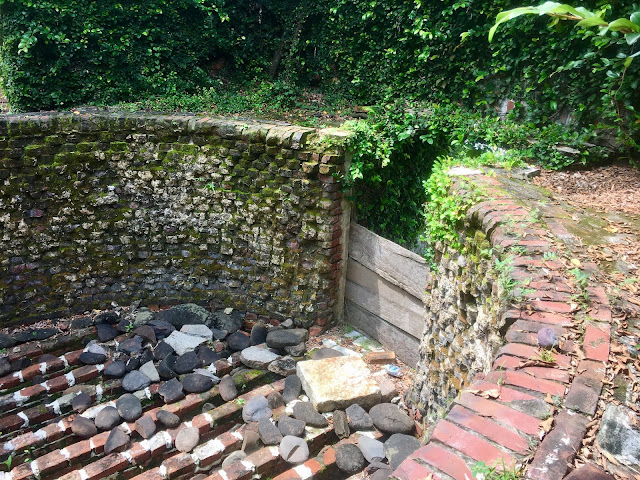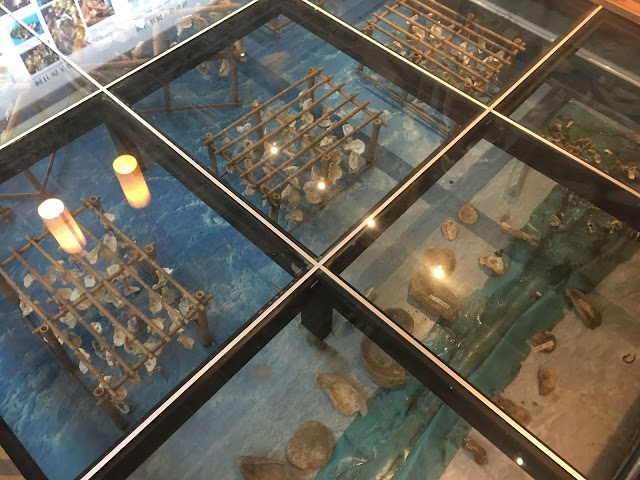It's our second time visiting Anping. Two years ago, we visited the five most popular places that can be visited with a single ticket. This time, I wanted to see some places we missed before. We visited Sio House (Salt Museum), Oyster Shell Kiln, Temple, Old Street, forts and castle and some smaller ancient buildings. Some places are free to visit, while others have an entrance fee of 50 NTD. Anping is one of my favorite places to visit, as it is full of history and street food can be found everywhere. In March 2012, Anping was named one of the Top 10 Small Tourist Towns by the Tourism Bureau of Taiwan. The older place name, Tayouan, comes from a nearby Taiwanese aboriginal tribe and was given by the Dutch and Portuguese. Han immigrants later renamed the area "Anping" after the Anping Bridge in Fujian. Soon after Qing rule was established in 1683, the name "Taiwan" (臺灣) was officially used to refer to the entire island with the establishment of Taiwan Prefecture.
Oyster Shell Cement Kiln Museum (安平蚵灰窯文化館)
The Oyster Shell Cement Kiln (蚵灰窯) was once the most important building material factory in Anping and is now the only surviving oyster shell kiln in Taiwan. Since the 1600s, oyster shell ash has been an essential material for boat-making and construction for the people of Anping who relied on the sea for their livelihoods. Initially, oyster shell ash was used alone, but later, sugar water and glutinous rice water were added to make bricks and tiles for building houses. The unique structure of the Anping oyster-ash kiln features a cubical exterior and a domed interior. Its main weight-bearing structure is made of red bricks and is larger than the average kiln. The interior is approximately 4 meters in diameter and taller than an average person, with the thinnest sections of the walls measuring about 1 meter.
In the museum, visitors can learn about the oyster growing process, ecology, and oyster shell ash production. However, the birth of modern lime industry in the 17th and 18th centuries led to the gradual dismantling of oyster-ash kilns. Nowadays, the preserved oyster-ash kiln in Anping is the only one remaining.
See also: Salt Museum
Bricks are arranged in rows to form gutters at the bottom of the kiln, allowing fresh air to flow in and sustain combustion.
Stone shingles are placed on top of the gutters, and smaller shingles fill the gaps to facilitate air convection.
Rice straws are placed on top of the shingles for ignition.
Fir chips are laid on top of the rice straws to feed the fire.
The burning fir chips and rice straws ignite the coal. The high temperature inside the kiln keeps it smoldering for several days. Peddles (a type of tool) are used to pump air into the kiln at a slow and constant rate to control the fire's size. Maintaining the fire for days is necessary for successful oyster ash production. In the past, workers took turns monitoring and adding air to the kiln. However, electric motors have simplified this task.
Carefully selected oyster shells are placed on top of the coal. The high temperature causes the moisture in the shells to evaporate, resulting in the decomposition of the shells into oyster ash and carbon dioxide. The oyster ash can be used as cement.
7/8. The coal and oyster shells are alternately stacked, and the amount of ash produced depends on the number of layers.
The oyster ash produced in the kiln is screened over a trench with an 80 to 100 count brass screen. Larger particles are discarded, while fine oyster ash powder remains. The fine powder is primarily used in building construction and is promptly packaged for storage or delivery. Prolonged exposure to open air can cause degradation due to moisture and carbon dioxide absorption.
Limestone and Tung Oil Cement
Limestone, a sedimentary rock containing calcium carbonate, turns into quicklime when heated to 800°C in the kiln. Quicklime reacts vigorously with water to produce slaked lime, which is used as a building material. Oyster-ash cement has been replaced by slaked lime, as it is cheaper and more readily available.
Tung oil, extracted from the seeds of tung trees, is a brownish-colored oil. It can be used raw or heated and purified to produce thick oil. Raw tung oil, when combined with oyster ash, becomes sticky and forms a gel-like substance.
See also: Anping Old Street
















0 komentarze:
Post a Comment